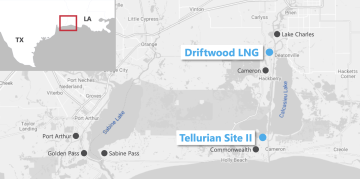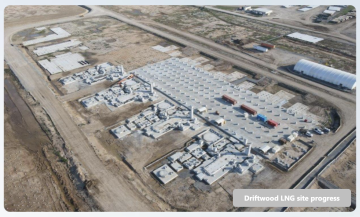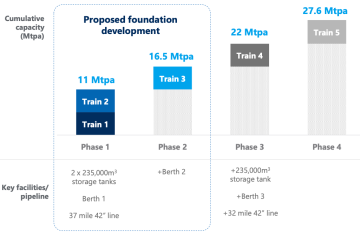Woodside Energy is buying Tellurian and its Driftwood LNG development project on the US Gulf Coast in a move calculated to propel the Australian operator into global LNG prominence.
On 21 July, both companies announced the deal, which includes an all-cash payment of about $900 million plus debt and has an implied enterprise value of $1.2 billion. In connection with the deal, Woodside will provide a loan to Tellurian of up to $230 million to ensure Driftwood LNG site activity and de-risking activities maintain momentum before the transaction is completed.
During a conference call discussing the acquisition, Woodside CEO Meg O’Neill said part of the attraction was the fact that Tellurian’s Driftwood LNG development is fully permitted, has key civil work already completed, and has expansion potential, although the project has not yet reached final investment decision (FID).
“This opportunity’s been under development since 2017, and we’ve been talking on and off about our interest in US LNG with Tellurian and other players for a number of years,” she said. “We came to a point where we had sufficient confidence that Driftwood was the right opportunity for us.”
Tellurian’s Go-Ahead
Tellurian’s board of directors has approved the transaction. In a 21 July letter to shareholders, Tellurian Executive Chairman Martin Houston urged shareholder approval of the $1/share deal, which represents a 75% premium on Tellurian’s closing price as of 19 July, and a 48% premium to Tellurian’s 30-day volume weighted average price.
The offer “fully reflects the company’s recent progress. When we instituted new leadership last December, Tellurian faced significant challenges,” he wrote in the letter.

In December 2023, Tellurian ousted chairman and co-founder Charif Souki and named Houston, who was co-founder and vice chairman, the director of the board of directors.
“We have been executing our refreshed strategy focused on strengthening the company’s position, improving our commercial offering, and bringing Driftwood to FID. This offer would not have materialized without the hard work and advances made over these last several months,” he wrote.
Despite the progress, he added, it was clear the company’s situation required consideration of “all possible alternatives, including a potential sale.”
The board decided the “attractive offer in hand outweighed the risks and uncertainty associated with going it alone,” Houston wrote.
Further, Houston said, because Woodside already has equity LNG in Australia and a strategy to grow it globally, a purchase by Woodside offers advantages that “cannot easily be replicated by Tellurian on a standalone basis and provide a strong rationale for Woodside for the transaction.”
Clean Slate for Driftwood
O’Neill said acquiring Tellurian gives Woodside a “clean slate” for the Driftwood project.
“We have full control of the site, so we can be very disciplined in our selection of the partners and very disciplined in the commercial models that we put in place, as opposed to having to negotiate with existing incumbents,” she said.
She said the deal, with its implied enterprise value of $1.2 billion, “provides a cost-competitive entry into a near-FID-ready, fully permitted development that has had over $1 billion expenditure incurred to date in engineering and pre-FID civil and site works.”
The multiphase project near Lake Charles, Louisiana, includes up to five LNG trains and has permitted capacity of 27.6 mtpa. The project also includes a 37-mile pipeline, which provides multiple options for sourcing low-cost feed gas, while a second 780-acre expansion site offers future development optionality.

Daniel Kalms, Woodside’s chief operating officer, international, said during the call that it is common in the US for some construction activity to precede FID.
“One of the attractive elements of the Driftwood opportunity is that the construction has commenced,” he said. “For Train 1, the gas turbine and LNG compressor foundations are complete. Progress has also been made on some ancillary scopes, including the grading and piling work for the tanks and utilities. This completed groundwork has reduced the risk of the EPC (engineering, procurement, and construction) timeline and its associated costs.”
Woodside aims to close the transaction in the fourth quarter 2024 and targets Driftwood Phase 1 FID as early as the following quarter. The transaction is subject to customary closing conditions, including approval from Tellurian shareholders and regulatory approvals.
“The project is fully permitted. We’ve got a FERC approval that goes out to quarter two of 2029. We believe that if we take FID around that time frame, then we’re able to achieve commercial operations before we get to that date,” Kalms said.
Phases 1 and 2 include three trains of around 5.5 mtpa each, while Phases 3 and 4 include one train each.
“The phased approach allows us to manage the pace of investment and also provides the ability to incorporate the latest technology in future phases,” Kalms said.

Woodside estimates development costs of $900 to $960 per tonne of capacity for Phases 1 and 2, which includes EPC, owner's costs, and contingency but excludes the pipeline, he said. Bechtel, which is the EPC contractor for Woodside’s Pluto Train 2 development in Western Australia, has a lump-sum turnkey contract for the Driftwood project.
Before Woodside can take FID on Driftwood, O’Neill said, the operator must close on the Tellurian transaction. Other steps include finalizing the contract with Bechtel and the possibility of bringing partners into the project.
“We do not intend to project finance. The timeline to do that is inconsistent with trying to move the project forward at pace, so that is not something we would intend to do,” she said.
Woodside’s Expanding LNG Footprint
O’Neill said the Driftwood LNG development offers a pathway to complement Woodside’s existing Australian LNG position by increasing the company’s presence in the Atlantic Basin. Woodside will have the advantage of being able to sell LNG in different markets to take advantage of volatility in the LNG market, she said.
“Having LNG exposure on all three indices allows us the opportunity to capture the market at the points in time where one index is out of sync with others,” she said. “We see significant value in complementing our Pacific Basin position with one in the Atlantic Basin.”
O’Neill said Woodside remains certain LNG will play an important role in the energy transition
“This acquisition increases our exposure to this market and strengthens our position as a global LNG player,” she said.
She also noted the Driftwood LNG development is carbon competitive. Because the design incorporates elements more advanced than prior generations of LNG trains, it has the potential to reduce the average Scope 1 and 2 emissions intensity of Woodside's LNG portfolio, she said.
“There is also potential for further decarbonization over the life of the asset, given the developing carbon capture and storage industry on the US Gulf Coast,” she added.


